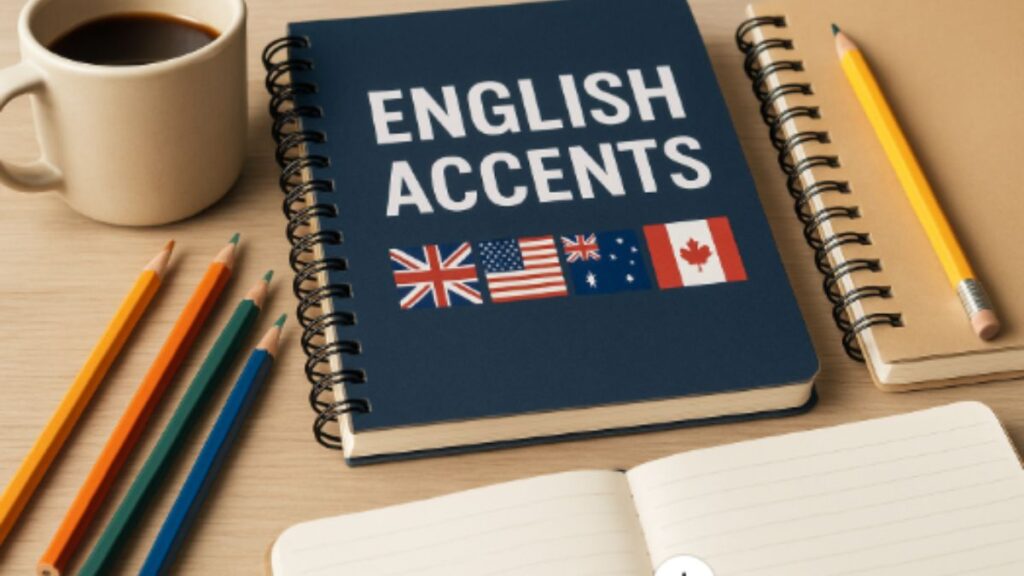Introduction
“Language is the road map of a culture. It tells you where its people come from and where they are going.” — Rita Mae Brown. This quote perfectly captures how regional speech patterns reveal history and identity.

With over 1.5 billion speakers worldwide, this global language boasts 160+ unique dialects. From Scotland’s rolling “r”s to Australia’s vowel shifts, these variations create a rich linguistic tapestry. The English Accents.
What makes Australian speech stand out? Unlike Britain’s 56 regional variations, the General Australian accent remains remarkably consistent across the continent. Yet subtle differences like “payn” for “pen” can still trip up learners.
This guide breaks down key features across three major variants. Discover how historical influences shaped modern pronunciation and why words like “pants” mean entirely different things across oceans.
Key Takeaways
- Global English has 160+ distinct dialects with unique sounds
- Australia’s accent shows surprising uniformity nationwide
- Vowel shifts create noticeable pronunciation differences
- Common words often have conflicting meanings
- Historical events shaped modern speech patterns
1. English Accents: A Global Overview
Linguistic diversity transforms a global language into a mosaic of regional identities. While grammar rules remain largely consistent, pronunciation and word choice vary dramatically. These differences often stem from historical migration, media influence, and social stratification.
The Role of Accents in Language Identity
Accents differ from dialects by focusing solely on the manner of speaking. Dialects include unique vocabulary and grammar. Both signal cultural belonging—think of the Australian rising inflection or London’s dropped h sounds.
Speech patterns also reflect social positioning. British Received Pronunciation (RP) became prestigious through BBC broadcasts. Meanwhile, Australia’s Broad accent carries working-class connotations.
Why Compare Australian, British, and American English?
These three variants dominate global media and business. Hollywood spreads American terms, while British RP remains an education standard. Australian English gains traction through tourism and shows like Neighbours.
Australia’s accent system includes:
-------- Continua após a publicidade --------
- Broad: Strong vowel shifts (“feesh” for fish)
- General: Most common, moderate speech
- Cultivated: Closer to British RP, now rare
| Feature | UK | US | Australia |
|---|---|---|---|
| Regional Variants | 40+ | 8 major | 3 primary |
| Media Influence | BBC | Hollywood | Streaming |
| Prestige Form | RP | General American | General |
Aboriginal English and Torres Strait dialects add further richness. Their melodic rhythms and storytelling structures differ markedly from mainstream patterns.
Why Accents Matter
Speech isn’t just about communication—it’s a cultural badge. Received Pronunciation (RP), spoken by just 3% of Brits, still dominates media and education. Linguist David Crystal notes:
“RP’s prestige persists because it’s tied to power structures, not popularity.”
2. Pronunciation Differences: Vowels and Consonants
Speech creates the most noticeable divides between global English variants. While grammar and vocabulary overlap, sound variations instantly signal whether a speaker is from Sydney, London, or New York. These distinctions often trace back to historical migrations and local linguistic evolution.
The “R” Sound: Rhotic vs. Non-Rhotic Accents
Rhoticity—whether the “r” is pronounced after vowels—splits English dialects. Americans say “hard” (with a strong “r”), while British RP and Australian speakers drop it (“hahd”). This feature stems from 18th-century British class distinctions, later exported globally.
Exceptions exist. Bostonians mimic British non-rhoticity (“pahk the cah”), while Scots roll their “r”s robustly. Australia’s “watah” for “water” reflects its British roots, though younger generations sometimes adopt rhotic sounds from media.
Vowel Variations: Trap-Bath Split and Flat “A”
Vowel shifts further differentiate dialects. The trap-bath split—where British English pronounces “bath” with a broad “a” (“bahth”) but Americans use a flat “a” (“bath”)—originated in southern England. Australia mostly follows the British pattern, though less consistently.
Notable quirks:
- Australian /æ/ raising: “Dance” becomes “dahnce” before nasal sounds
- Cockney th-fronting: “Think” sounds like “fink”
- Canadian raising: “About” leans toward “aboot”
| Feature | American | British | Australian |
|---|---|---|---|
| “R” pronunciation | Rhotic | Non-rhotic | Non-rhotic |
| “A” in “dance” | Flat | Broad | Raised |
| Vowel shifts | Minimal | Moderate | Pronounced |
These features highlight how tiny sound changes create vast differences in global speech.
3. Distinctive Intonation Patterns
The melody of speech reveals as much about a culture as its words. While vocabulary and grammar unite global speakers, pitch patterns carve out regional identities. These subtle rises and falls signal questions, authority, or friendliness—often without changing a word.
British RP’s Precise Cadence
Received Pronunciation (RP) uses a rising inflection for questions, like a musical scale climbing upward. BBC newscasters exemplify this “cut glass” tone: *”The prime minister will speak ↗tomorrow?”* In contrast, statements drop sharply, conveying formality.
Welsh English adds a sing-song quality, while Geordie (Newcastle) dialects bounce between highs and lows. These variations affect perceived politeness—RP’s crisp falls sound authoritative, whereas Estuary English’s smoother flow feels approachable.
Australia’s Upward Lilt
Australian speech often ends statements with a rising terminal, making *”It’s hot today”* sound like a question. This trait, called “high rising terminal,” likely emerged from Irish influences. Younger generations amplify it, especially in urban areas.
Unlike London’s rhythmic drops, Sydney’s broad accent stretches vowels melodically. Listen for *”no”* becoming *”no-uh”*—a feature shared with some Southern U.S. dialects but rare in Britain.
American Neutrality and Exceptions
General American favors flat intonation, particularly in the Midwest. News anchors use steady pitches to sound neutral. Yet regional quirks break the mold:
- Valley Girl: Exaggerated rises (*”Like, totally ↗cool?”*)
- Southern drawl: Slowed, sliding pitches (*”Y’all come ↘back now”*)
| Feature | British RP | Australian | General American |
|---|---|---|---|
| Question pitch | Sharp rise | Moderate rise | Slight rise |
| Statement end | Falling | Rising | Neutral |
| Politeness cue | Formal drop | Friendly lift | Steady tone |
These sound features shape global perceptions—Australians sound laid-back, Brits precise, and Americans direct. Mastering them helps learners blend in seamlessly.
4. Vocabulary and Spelling Variations
Words paint cultural identities differently across continents. While grammar rules stay consistent, regional terms and spelling create instant divides. A “boot” in London is a “trunk” in Los Angeles—small differences with big impacts.

British vs. American: “Lorry” or “Truck”?
Automotive terms highlight key features of each dialect. Brits pop the “bonnet”, while Americans lift the “hood”. These variations trace back to 19th-century industrialization.
Common false friends include:
- UK “jumper” = US “sweater”
- UK “chips” = US “fries” (UK “crisps” = US “chips”)
- UK “pants” (underwear) vs. US “pants” (trousers)
Australian Slang: “Arvo” and “Brekkie”
Australia’s language thrives on abbreviations. A “barbie” isn’t a doll—it’s a barbecue. “Sunnies” replace sunglasses, and “ute” refers to pickup trucks.
Unique terms to know:
- “Arvo” = afternoon
- “Brekkie” = breakfast
- “Bottle-o” = liquor store
| Term | UK | US | Australia |
|---|---|---|---|
| Car storage | Boot | Trunk | Boot |
| Letter Z | Zed | Zee | Zed |
| Spelling | Colour | Color | Colour |
These dialects prove how words evolve independently, yet remain part of a shared global language.
5. Regional Sub-Accents Within Each Country
Cities and regions often develop unique vocal fingerprints within shared languages. While national accents provide broad categorization, local speech patterns tell richer stories of migration, class, and isolation. These micro-dialects frequently become markers of regional pride and identity.
British Diversity: Cockney, Scouse, and Geordie
Britain’s compact geography hosts dozens of distinct dialects. London’s Cockney accent, born in working-class East End, features th-fronting (“think” becomes “fink”). Liverpool’s Scouse shows strong Irish influences, while Newcastle’s Geordie preserves ancient Anglo-Saxon vowels.
Key contrasts:
- Contém 121 cartas no formato 63mm x 88mm
- Escolha seu lado: heróis ou vilões Pokémon – Com Giovanni, Mewtwo ex, Cíntia, Ho-Oh ex e mais!
- Expansão Escarlate e Violeta – Rivais Predestinados – A mais nova e intensa saga do Pokémon Estampas Ilustradas.
- Brummie (Birmingham): Flattened vowels (“cup” sounds like “cop”)
- Manchester: Shortened words (“nothing” becomes “nowt”)
- Glasgow: Rolled “r”s and clipped endings
American Contrasts: Southern Drawl vs. New York Twang
The U.S. exhibits dramatic shifts between areas. Southern speech slows vowels (“time” becomes “tahm”), while Boston drops post-vowel “r”s (“park the car” sounds like “pahk the cah”). New York’s distinctive “cawfee” for “coffee” persists despite media homogenization.
| Feature | Texas | Minnesota |
|---|---|---|
| Vowel length | Extended | Nasalized |
| Influences | Spanish | Scandinavian |
Australian Uniformity vs. Subtle State Differences
While Australia’s regional accents show less variation than Britain’s, subtle differences emerge. Queenslanders stretch vowels more than Victorians. Adelaide retains traces of British RP, while Western Australia develops unique rising inflections.
Notable variations:
- NSW: Broad vowel shifts (“fish” → “feesh”)
- Tasmania: Softer consonant endings
- Northern Territory: Aboriginal English influences
These local flavors prove that even within standardized national speech, geography leaves audible marks.
languages evolve within communities. For more on regional quirks, explore this guide to global accents.
6. Influence of History and Migration
Historical events left deep marks on how people speak across different regions. From convict ships to mass migrations, each wave of settlers reshaped local language. These changes reveal stories of survival, adaptation, and identity.

How Colonialism Shaped Australian English
Australia’s speech traces back to the 1788 First Fleet. Convicts from London’s working-class neighborhoods brought Cockney slang and dropped “h” sounds. Over time, isolation smoothed these rough edges into today’s General Australian accent.
Key developments:
- Aboriginal English: Blends traditional grammar (e.g., “we been go”) with mainstream vocabulary
- Multicultural influences: Post-WWII migrants added Italian and Greek rhythms to urban speech
- Irish intonation: Rising terminals (*”flat tone?↗”*) mirror Dublin’s melodic patterns
Irish and Scottish Impact on British Accents
The 1840s Irish migration transformed Liverpool’s Scouse accent. Listen for:
- Softened “t” sounds (*”butter”* → *”buh-er”*)
- Ulster Scots’ vowel length in Northern England (*”house”* → *”hoose”*)
London’s Multicultural Youth Dialect (MLE) mixes Caribbean patois, South Asian rhythms, and Cockney slang. Words like *”mandem”* (friends) reflect modern diversity.
| Influence | UK | Australia | US |
|---|---|---|---|
| Irish | Scouse accent | Rising inflection | Boston “r” drop |
| Scottish | Northern vowels | – | Appalachian twang |
| Indigenous | – | Aboriginal English | Navajo loanwords |
From Cornish revivals to Māori language blends, these history lessons prove speech is never static. Every accent carries echoes of the past.
7. Common Misunderstandings and Pitfalls
Navigating global language variants often feels like walking through a verbal minefield. What sounds polite in one country might cause confusion—or even offense—in another. These pitfalls stem from overlapping words with entirely different meanings across regions.
Words That Sound Similar but Differ in Meaning
Homophones create some of the trickiest differences for learners. Scottish “ken” means “know,” while general English speakers hear it as a name. Australians ordering “chips” get thick fries, whereas Americans receive thin potato crisps.
Other confusing pairs include:
- UK “plait” vs US “braid” (same hairstyle, different terms)
- Australian “thong” (flip-flop) vs American underwear
- “Biscuit” meaning cookie (UK/AU) vs savory bread (US)
False Friends: When Familiar Words Betray You
These linguistic traps occur when speakers assume shared meanings. Medical terms particularly differ—Brits rush to “A&E” (Accident & Emergency) while Americans head to the “ER.” Even sidewalks divide nations: Australians walk on “footpaths,” Americans on “sidewalks.”
Speech adds another layer. Canadians say “hydro” for electricity bills, confusing visitors expecting water references. The British “aluminium” (five syllables) clashes with America’s four-syllable “aluminum.”
| Term | UK/AU | US |
|---|---|---|
| Swimwear | Budgie smugglers | Speedos |
| Z pronunciation | Zed | Zee |
| Pharmacy | Chemist | Drugstore |
Mastering these nuances prevents awkward mix-ups. As global communication increases, recognizing regional sound and meaning shifts becomes essential for clear understanding.
8. Media and Pop Culture’s Role in Accent Perception
Pop culture acts as a powerful amplifier, broadcasting regional speech to worldwide audiences. Films, news, and streaming platforms shape how accents are heard—and judged—across continents. From Hugh Grant’s posh RP to Steve Irwin’s broad Australian twang, media exports turn local dialects into global trademarks.
British RP’s Evolution on Screen
The BBC once standardized Received Pronunciation (RP) for newsreaders, but today’s shows like Peaky Blinders celebrate regional voices. Reality TV fuels “Mockney”—a fake Cockney accent adopted by 73% of UK stars to sound relatable. Meanwhile, Downton Abbey revived RP’s prestige for period dramas.
Hollywood’s Linguistic Dominance
American media exports General American as the default “neutral” dialect. Classic films used the mid-Atlantic accent (a blend of US and RP) for sophistication. Modern blockbusters, however, exaggerate New York gangster drawls or Southern charm, reinforcing stereotypes.
Australian Soaps and Global Recognition
Shows like Neighbours and Home & Away popularized Aussie slang (“arvo,” “brekkie”). Steve Irwin’s enthusiastic delivery became synonymous with Australian English, while Crocodile Dundee exported phrases like “throw another shrimp on the barbie.”
| Media Influence | UK | US | Australia |
|---|---|---|---|
| Prestige Accent | RP (BBC) | General American | General Australian |
| Cultural Export | Mockney | Valley Girl | “Strine” slang |
| Global Reach | Taika Waititi’s films | Hollywood | Streaming soaps |
From Māori English in Thor: Ragnarok to Boston’s dropped “r”s in The Departed, media both reflects and reshapes how speakers worldwide perceive linguistic identity.
9. Tips for Learners: Mimicking Accents Effectively
Mastering regional speech patterns requires more than memorizing vocabulary—it demands active listening and precise muscle memory. Whether aiming for Australian casualness or British precision, targeted exercises help bridge the gap between understanding and authentic Speech pronunciation.
Listening Exercises for Australian English
ABC News anchors provide clear examples of General Australian sound patterns. For casual speech, podcasts like Chat 10 Looks 3 showcase natural rhythms. Focus on:
- Vowel shifts: Note how “day” sounds closer to “die”
- Rising inflections: Practice ending statements with upward pitch
- Slang integration: Record yourself using terms like “arvo” in sentences
Mastering British English Through BBC Resources
BBC Learning English offers free Speech guides with IPA charts. Try these steps:
- Watch videos on RP vowel positions
- Mirror mouth shapes for crisp “t” sounds
- Repeat after the newsreaders, focusing on clipped consonants
Shadowing Techniques for American English
TED Talks provide ideal material for shadowing General American cadence. Advanced learners benefit from:
- Tagging in language exchanges (request accent-specific feedback)
- Tongue drills for rhotic “r” sounds
- Regional media immersion (Southern dramas for drawls, sitcoms for Californian lifts)
| Resource | Skill Focus |
|---|---|
| YouTube coaches | Lip/tongue positioning |
| IPA charts | Vowel comparison |
| Mirror practice | Visual articulation checks |
Consistency matters most. Daily 15-minute sessions yield better results than weekly marathons. Join groups like Meetup’s accent circles for real-world practice. Over time, these techniques transform passive knowledge into confident speakers.
If you’re exploring different English accents, chances are you’re also working on refining your grammar to sound more fluent and natural. For advanced learners looking to upgrade their skills, don’t miss our guide on 7 Essential Advanced English Grammar Structures. It’s packed with practical examples to help you speak and write with greater precision—no matter your accent.
10. Conclusion: Celebrating the Diversity of English Accents
From boardrooms to classrooms, the global tapestry of speech continues to evolve. Over 24 African nations and 75 million Pidgin speakers showcase this language’s adaptability. Its role as a bridge across cultures remains unmatched.
Embracing differences fosters inclusivity. Workplaces benefit from accent diversity, while media and tech reshape how we hear the world. Streaming platforms preserve rare dialects, from Appalachian twangs to Aboriginal rhythms.
Looking ahead, accents may blend but won’t vanish. Each vocal quirk—whether a Boston “r” drop or Sydney’s rising lilt—holds cultural stories. Explore them through podcasts, films, and conversations.
- Preserve: Support endangered dialects like Cornish or Māori English
- Learn: Use apps to compare Speech side-by-side
- Celebrate: Every accent reflects a unique heritage
In this connected era, linguistic diversity isn’t just noise—it’s humanity’s shared soundtrack.
FAQ
What makes Australian, British, and American English different?
These variations differ in Speech, vocabulary, and intonation. For example, British English often drops the “R” sound, while American English pronounces it clearly. Australian speech has a distinct musical lilt.
Why do some British accents sound so different from each other?
The UK has strong regional diversity, with accents like Cockney, Scouse, and Geordie shaped by history, migration, and local culture. These differences reflect centuries of social and linguistic evolution.
How does Australian slang differ from American or British terms?
Aussie slang often shortens words, like “arvo” for afternoon or “brekkie” for breakfast. These informal terms are less common in the US or UK, where phrases like “truck” (US) and “lorry” (UK) highlight vocabulary contrasts.
Can media help in learning different English accents?
Yes! Watching BBC shows can improve the British manner of speech, while Hollywood films showcase American speech patterns. Australian soaps like “Neighbours” offer exposure to the country’s unique intonation and slang.
What’s the easiest way to mimic an accent accurately?
Practice shadowing—repeat dialogues from native speakers. Use resources like the BBC for British English or American podcasts. Focus on vowel sounds and rhythm, which vary significantly between accents.
Are there words that mean different things in these English variants?
Absolutely. For example, “pants” refers to trousers in the US but underwear in the UK. Such “false friends” can lead to funny misunderstandings if not used correctly.









Boa noite. Excelente seu artigo. Uma explicação muito rica sobre as diferenças de pronúncias.